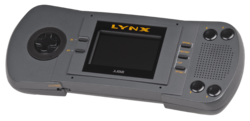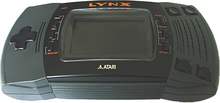- Atari Lynx
-
Atari Lynx 
Atari Lynx IDeveloper Epyx/Atari Manufacturer Atari Corporation Generation Fourth generation Release date 1989 Retail availability September 1989[1] Units sold 5 Million Media Cartridge CPU MOS Technology 6502 Graphics 160 × 102 standard resolution (16,320 addressable pixels) Online services ComLynx
(17 player networking)The Atari Lynx is a 16-bit handheld game console that was released by Atari Corporation in 1989. The Lynx holds the distinction of being the world's first handheld electronic game with a color LCD. The system is also notable for its forward-looking features, advanced graphics, and ambidextrous layout. The Lynx was released in 1989, the same year as Nintendo's best-selling, monochromatic Game Boy. However, the Lynx failed to achieve the sales numbers required to attract quality third party developers, and was eventually abandoned.
Today, as with many older consoles, there is still a small group of devoted fans, creating and selling games for the system.[2]
Contents
Features
The Atari Lynx has several innovative features including its being the first color handheld, with a backlit display, a switchable right-handed/left-handed (upside down) configuration, and the ability to network with up to 17 other units via its "ComLynx" system (though most games would network eight or fewer players). ComLynx was originally developed to run over infrared links (and was codenamed RedEye).[3] This was changed to a cable-based networking system before the final release.
The Lynx was also the first gaming console with hardware support for zooming/distortion of sprites, allowing fast pseudo-3D games with unrivaled quality at the time and a capacity for drawing filled polygons with limited CPU intervention. Blue Lightning, a game with After Burner-like graphics, was especially notable and featured in TV advertising for the console.
The games were originally meant to be loaded from tape, but were later changed to load from ROM. The game data still needed to be copied from ROM to RAM before it could be used, so less memory was available and the games loaded relatively slowly.[1]
History
The Lynx was the second handheld game with the Atari name to actually be produced, the first was Atari Inc.'s handheld electronic game Touch Me. Atari Inc. had previously worked on several other handheld projects including the Breakout, Space Invaders, and the Atari Cosmos portable/tabletop console. However, those projects were shut down during development - some just short of their intended commercial release.
The Lynx system was originally developed by Epyx as the Handy Game. Planning and design of the console began in 1986 and completed in 1987.[1] Epyx first showed the Handy system at the Winter Consumer Electronics Show (CES) in January 1989. Facing financial difficulties, Epyx sought out partners. Atari Corp. and Epyx eventually agreed that Atari Corp. would handle production and marketing, while Epyx would handle software development.
Atari Corp. changed the internal speaker and removed the thumb-stick on the control pad before releasing it as the Lynx, initially retailing in the US at US$179.95. Atari Corp. then showed the Lynx to the press at the Summer 1989 CES as the "Portable Color Entertainment System", which was changed to Lynx when actual consoles were distributed to resellers.[1]
However, Nintendo's new Game Boy was also introduced at the 1989 CES. At $90, it was much less expensive than the Lynx, without the color or custom chips. Nintendo had no problems supplying retailers with the Game Boy for the Christmas season while Atari Corp. only managed limited distribution of their Lynx by year's end.
During 1990, the Lynx had moderate sales but Nintendo's Game Boy continued to gain market share. In 1991, Atari Corp. relaunched the Lynx with a new marketing campaign, new packaging, slightly improved hardware, and a new sleek look. The new system (referred to within Atari Corp. as the "Lynx II") featured rubber hand grips and a clearer backlit color screen with a power save option (which turned off the LCD panel's backlighting). It also replaced the monaural headphone jack of the original Lynx with one wired for stereo. The new packaging made the Lynx available without any accessories, dropping the price to $99. Although sales improved, Nintendo still dominated the handheld market.
As with the actual console units, the game cartridges themselves evolved over the first year of the console's release. The first generation of cartridges were flat, and were designed to be stackable for ease of storage. However, this design proved to be very difficult to remove from the console and was replaced by a second design. This style, called "tabbed" or "ridged", used the same basic design as the original cartridges with the addition of two small tabs on the cartridge's underside to aid in removal. The original flat style cartridges could be stacked on top of the newer cartridges, but the newer cartridges could not be easily stacked on each other, nor were they stored easily. Thus a third style, the "curved lip" style was produced, and all official and third-party cartridges during the console's lifespan were released (or re-released) using this style.[4]
In May 1991, Sega launched its Game Gear portable gaming handheld. Also a color handheld, in comparison to the Lynx it had a higher cost, slightly smaller bulk, and worse battery life. However, the Game Gear was backed up by significantly more popular titles and consequently the market became dominated by Nintendo followed by Sega in a distant second and the Lynx in third except in the UK and parts of Europe such as France and Holland where the Lynx retained 2nd place.
In 1994, Atari Corp. shifted its focus away from the Lynx. As Nintendo's Super Nintendo and Sega's Mega Drive/Genesis filled retailers' shelves, Atari Corp. refocused its efforts on its Jaguar console. A handful of games were released during this time, including Battlezone 2000. In 1996, Atari shut down its internal game development.
Telegames released a number of games in the second half of the 1990s, including a port of Raiden and a platformer called Fat Bobby in 1997, as well as an action sports game called Hyperdrome in 1999. At the end of the 1990s, Hasbro, the owners of the Atari properties at the time, released the rights to develop for the system to the public domain. Since then a number of independent developers released games into the new decade, like Championship Rally, CyberVirus, and Alpine Games.[5] Some of the late 90s/early 2000s games were under development by other companies at one time, but rights to the game programs and all of the existing code was bought and finished by other developers.[6]
In 2008 Atari was honored at the 59th Annual Technology & Engineering Emmy Awards for pioneering the development of handheld games with its Lynx game unit.[7]
On October 24, 2009, North American company Super Fighter Team released Zaku, an all new, all original horizontal shooter for the Lynx developed by PenguiNet. Of significant note is that it was the first new game for the system whose game card has an authentic "curved lip" plastic shell. The game also shipped with a full color cardstock box, and 31 page instruction manual printed in both English and French.[8]
Reception
Although it was innovative and unique for its time, gamers found the Atari Lynx to be quite large and bulky, even the 2nd version of the unit.
However, the game system was reviewed in 1990 in Dragon #155 by Hartley, Patricia, and Kirk Lesser in "The Role of Computers" column. The reviewers gave the Lynx 5 out of 5 stars.[9]
Technical specifications
- MOS 65SC02 processor running at up to 4 MHz (~3.6 MHz average)
- 8-bit CPU, 16-bit address space
- Sound engine
- 4 channel sound (Lynx II with panning)
- 8-bit DAC for each channel (4 channels × 8-bits/channel = 32 bits commonly quoted)
- Video DMA driver for liquid-crystal display
- 4,096 color (12-bit) palette
- 16 simultaneous colors (4 bits) from palette per scanline (more than 16 colors can be displayed by changing palettes after each scanline)
- 8 System timers (2 reserved for LCD timing, one for UART)
- Interrupt controller
- UART (for ComLynx) (fixed format 8E1, up to 62500 Bd)
- 512 bytes of bootstrap and game-card loading ROM
- Suzy (16-bit custom CMOS chip running at 16 MHz)
- Graphics engine
- Hardware drawing support
- Unlimited number of high-speed sprites with collision detection
- Hardware high-speed sprite scaling, distortion, and tilting effects
- Hardware decoding of compressed sprite data
- Hardware clipping and multi-directional scrolling
- Variable frame rate (up to 75 frames/second)
- 160 × 102 standard resolution (16,320 addressable pixels)
- Math co-processor
- Hardware 16-bit × 16-bit → 32-bit multiply with optional accumulation; 32-bit ÷ 16-bit → 16-bit divide
- Parallel processing of CPU and a single multiply or a divide instruction
- Graphics engine
- RAM: 64 KB 120ns DRAM
- Storage: Cartridge - 128, 256 and 512 KB exist, up to 2 MB is possible with bank-switching logic.
Some (homebrew) carts with EEPROM to save hi-scores.
- Ports:
- Headphone port (3.5 mm stereo; wired for mono on the original Lynx)
- ComLynx (multiple unit communications, serial)
- LCD Screen: 3.5" diagonal
- Battery holder (six AA) ~4–5 hours (Lynx I) ~5-6 hours (Lynx II)
See also
- List of Atari Lynx games
- History of Atari
References
- ^ a b c d Peter Latimer (July 2005). "Atari Lynx". Retro Gamer 2 (6): Pages 24–31. ISSN 1742-3155.
- ^ Atari Age Self Published Lynx Games
- ^ Atari Explorer Lynx page
- ^ Atari Lynx cartridge style illustrations at AtariAge.com.
- ^ Alpine Games by Duranik
- ^ Songbird Productions' development page for CyberVirus
- ^ http://www.gamespot.com/news/6184421.html
- ^ Official Zaku website
- ^ Lesser, Hartley, Patricia, and Kirk (March 1990). "The Role of Computers". Dragon (155): 95–101.
External links
- Lynx at the Open Directory Project
- AtariAge – Comprehensive Lynx Database and information
- Review of the Atari Lynx 2 on YouTube
Atari hardware Personal computers Portable computers Video game consoles Pong · Stunt Cycle · Video Pinball · 2600 · 5200 · 2800 · 7800 · XEGS · Lynx · Jaguar (Jaguar CD) · Flashback · Flashback 2Cancelled prototypes Other Arcade games · Atari Video MusicHandheld game consoles Bandai Entex Game Park/Holdings Nintendo Game & Watch (Mini Classics) · Game Boy (Pocket · Light) · Game Boy Color · Game Boy Advance (SP · Micro · Visteon Dockable Entertainment) · Pokémon mini · Nintendo DS (Lite · DSi · DSi XL) · Nintendo 3DSNokia Sega SNK Sony Other handhelds 1970s1980s1990s2000s2010sEarly units · Comparison Categories:- 1989 introductions
- Handheld game consoles
- Fourth-generation video game consoles
- Atari consoles
- MOS 65SC02 processor running at up to 4 MHz (~3.6 MHz average)
Wikimedia Foundation. 2010.

